
Last week at the COP26 in Glasgow, more than 100 nations took the Global Methane Pledge and committed to reducing emissions of this dangerous greenhouse gas 30% by 2030. It was a shining moment in history as the world’s people came together to act for the common good.
When I say “the people of the world”, I actually don’t mean all of them. For a start, there wouldn’t be enough room. There are a few countries not taking part. Among them are China, India, Iran, and Russia. Australia is also one of them.
Under other circumstances, it might be nice to cosy up with a few major trading partners like this, but this is not a group it’s in our interest to join. India and Iran are poor nations, so I’m not going to pick on them for letting the opportunity pass by, but both China and Russia are solidly middle income and can afford to make the effort.
Most shamefully of all, Australians are five times richer on a per capita basis, and if any nation among the abstainers can afford to reduce methane emissions, we’re it.
We weren’t only faced with a clear moral choice. We also had to decide between acting sensibly and helping secure humanity’s future or acting stupidly and unnecessarily, putting it at greater risk.
Our leadership chose to be stupid.
Australia should have taken the pledge because it would be relatively easy for us to cut methane emissions 30% over the next eight years. Even from a completely venal point of view, we were idiots for not taking the easy win.
What The Hell Is Methane?
Methane is a colourless, flammable gas. It’s the main component of natural gas that we burn to generate electricity and provide heat for homes and industry. It’s produced naturally by methanogenic microorganisms found in rotting vegetation, soil, and the digestive tracts of animals such as cows, sheep, and termites.
It’s an odourless gas. This may surprise those who think it’s a major component of flatulence, but humans are minor producers of digestive methane. Although there are exceptions.
Methane is a powerful greenhouse gas and behind a hefty chunk of global warming. Methane emissions from civilization are roughly responsible for 16% of global warming that has occurred over the past few hundred years. But the calculations involved in working that out are really complex, and climatologists can get very cranky with idiots who try to guesstimate it down to a simple percentage.
Measured over 100 years, one tonne of methane emissions will result in around 34 times as much warming as one tonne of CO2 emissions1. Unlike CO2 — where much of what we’ve added to the atmosphere will still be there after thousands of years unless we do something about it — methane breaks down over time. After 50 years, most of what’s in the atmosphere now will be gone.
The half-life of atmospheric methane is around 12.4 years, but this can vary considerably for reasons we only partially understand. The graph below shows how methane breaks down over time:
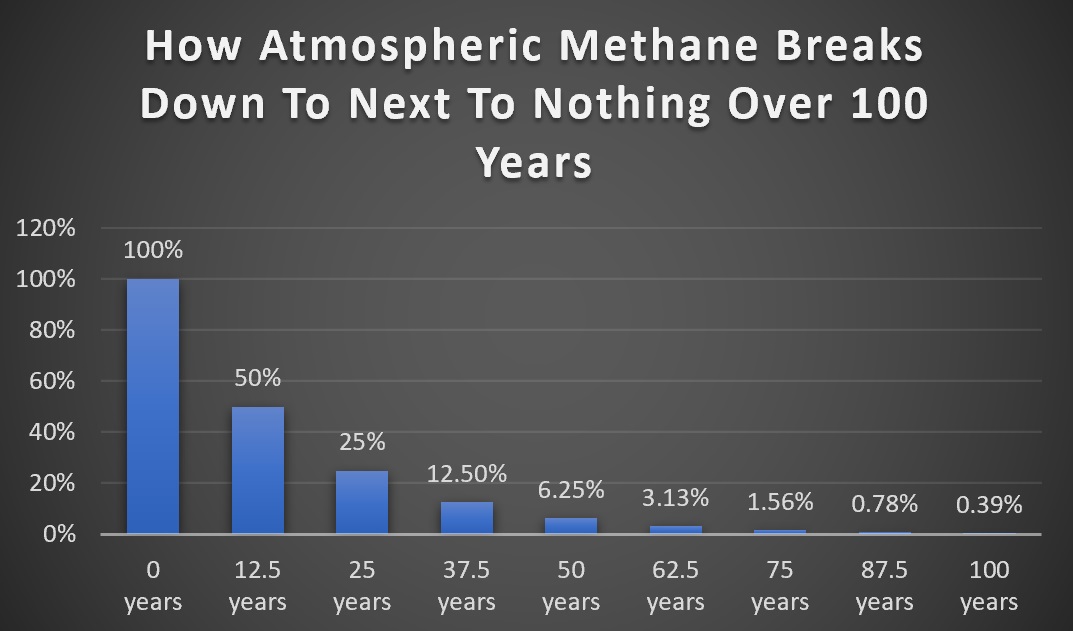
This graph assumes a methane half-life in the atmosphere of 12.5 years rather than 12.4. This is partly because the value is approximate but mostly because a round 100 years looks better than janky 99.2 years.
Because methane emitted today will be half gone after around 12 to 13 years, its warming effect is front-loaded. While over 100 years its warming effect will be around 33 times greater than CO2, over 20 years its warming effect is around 80 times higher.
But that’s only considering the direct warming effects of methane. Unfortunately, it also interacts with aerosols in a way that increases its warming effect over 20 years to an estimated 104 times higher than CO2.
Because methane is a powerful greenhouse gas but also breaks down over time, cutting emissions now can significantly slow global warming over the next few decades. This means the Global Methane Pledge makes a lot of sense.
But before anyone gets too excited, I should mention when methane breaks down, it converts into CO2. While CO2’s greenhouse effect is much less powerful, it does mean all the warming from methane emissions won’t disappear if we wait 50+ years.
Natural Methane Emissions Not Counted
Around 40% of methane emissions are from natural sources such as wetlands and termites. These sources are not included in the Global Methane Pledge, which only covers emissions from human activity.
In Australia, emissions from cows and sheep are considered part of human activity, as our beef and wool industries weren’t created by mother nature. You might expect methane directly produced by humans would count as part of human activity but — interestingly enough — human farts are considered natural.
Australians only fart out around 3,000 tonnes of methane a year, which is under 3% of emissions from our other activities. I’m not saying it’s okay to fart as much as you want, but if you let one rip, it won’t interfere with any international agreements, provided it’s below the level of a nuclear weapons test.
Australia’s Methane Emission Levels
Here’s a graph of Australia’s methane emissions from human activity this century:
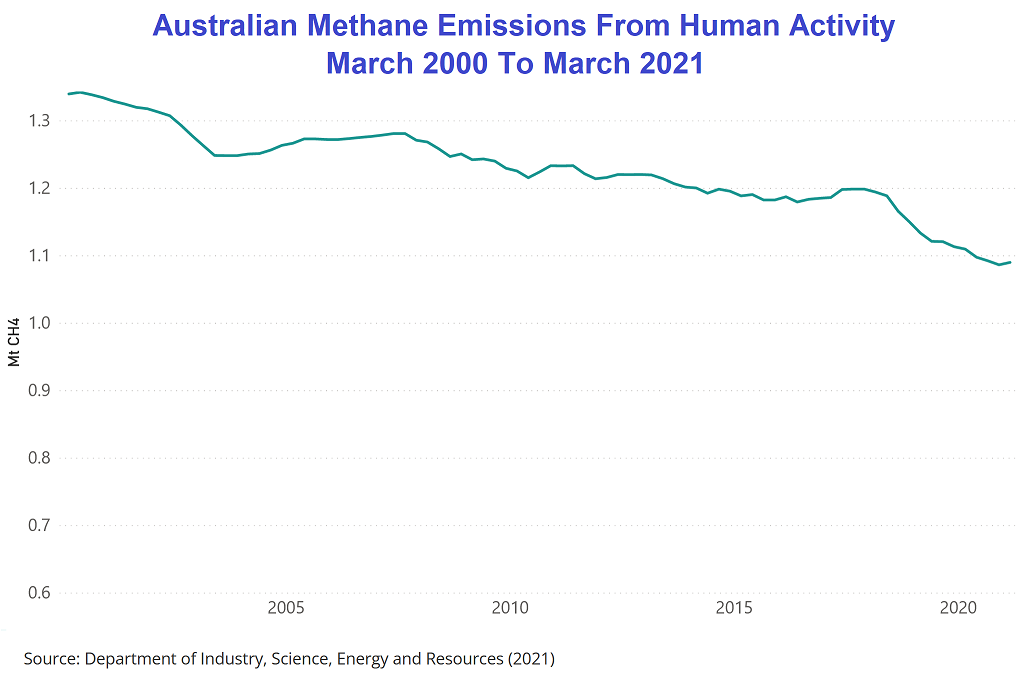
Graph taken from National Greenhouse Gas Inventory report, but I added the blue title.
As you can see, it has already been trending down, and if the rate continues, emissions will be 7% lower by 2030.
In 2020 methane emissions were 1.09 million tonnes2. If we’d joined the Pledge, our emissions would need to be 760,000 tonnes by 2030.
Australia’s population is now 25.9 million, with an average household size of 2.6 people. This means our current emissions average out to…
- 42 kg of methane emissions per person
- 110 kg of methane emissions per household
While around 110 kg per family may not sound too bad, if burned in a 50% efficient combined cycle gas power station, it would generate around 820 kilowatt-hours. So the methane our activity releases into the atmosphere is enough to generate the grid electricity consumption of Australian homes for around two months of the year.
Methane Emissions By Sector
Here’s a graph showing Australia’s methane emissions for 2020 by sector:
These figures are from the Australian Greenhouse Gas Inventory. There is some dispute over how accurate they are, but I’ll assume they’re close enough for the back of the envelope estimates I make in this article.
Note to politicians: “Back of the envelope” refers to simplified calculations. It does not mean deciding calculations are correct because they’re written on the back of an envelope stuffed full of cash.
Here’s a quick rundown of the emission sources:
Agriculture: Methane is released by methanogenic microorganisms in farm soils, the burning of agricultural wastes, and the use of nitrogen fertilizer. But over three quarters comes from cows and sheep farting, burping, and pooping.
Fugitive Coal Emissions: Fugitive emissions are accidental or unintentional emissions from industry. Those from coal mining are the second-largest source of Australian methane emissions. Most come from coal releasing methane after it has been dug up and crushed. This process creates heat and is one of the dangers of coal mining, as it can result in spontaneous combustion if care isn’t taken. (That’s spontaneous combustion of coal — not people in the area.)
Land Use: When land is cleared, the soil can release methane. The burning of vegetation also releases it. Anything that makes ground marshy or swampy can cause methane emissions from biomass rotting in a low oxygen environment.
Waste: This mostly comes from landfill. When our rubbish rots, microorganisms release methane.
Fugitive Emissions — Gas & Oil: It’s unclear how much emissions result from Australia’s coal seam gas extraction, but these figures put the total for gas and oil extraction at one-third of coal.
Electricity, Industry, and Transport: It may seem surprising that these large parts of the economy are only responsible for 2% of emissions, but there’s a simple reason. Unlike other sectors, they have to pay good money to be supplied with natural gas and have an incentive not to let it go to waste.
It’s Easy To Cut Coal & Gas Fugitive Emissions
Coal mining is responsible for around 21% of our methane emissions, so all Australia needs to do to meet the Global Methane Pledge is end coal mining over the next eight years, plus reduce emissions in other areas by 11.4% and we’re done. That’s a 30% reduction.
But I don’t think our Federal Government would consider that a good idea. While I think we should end domestic coal fired power generation over the next five years3 — with possible exceptions for seasonal or emergency use — officially our government doesn’t want to do that until 2051.
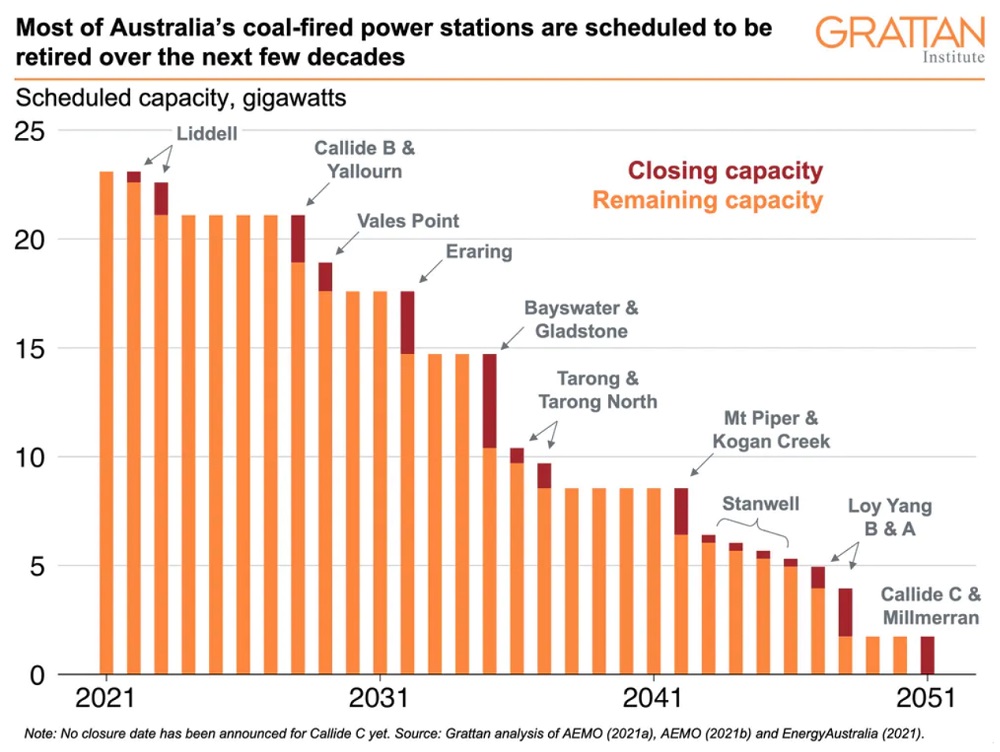
This graph was put together by the Grattan Institute and shows times given for Australian coal power station closures. According to this, we won’t be rid of coal power until 2051. (Note that, even though I’m aware this graph has been floating around the internet for a while, I am far too lazy to check if it needs to be updated.)
Fortunately, the actual chances of coal power lasting that long are around those of a snowball in hell — or most places on earth at the moment.
Instead of recognizing the world needs to rapidly phase out coal, our current leadership prefers to pretend demand for domestic and exported coal will be as strong in 2030 as it is now, and that’s not going to happen.
Low-cost renewables are killing coal generation in Australia, and our export markets have shown they are quite capable of investing in solar energy and wind power generation. Singapore, which is kind of crowded, is getting the Northern Territory to toss an extension cord across the Tasman Sea fence to Indonesia and then across the Java Sea so they can enjoy Australian solar power.
Metallurgical coal exports are also set to decline. This is used for steel making and, by tonnage, was 47% of Australia’s coal exports last financial year. Some decline may occur from increased steel production methods that don’t require coal, but the main fall is likely to come from reduced steel use in China.
There’s nothing unexpected about falling Chinese steel consumption at this point. Countries use a lot as they industrialise but then ease off and rely more on scrap metal. While other large countries such as India, Indonesia, and Nigeria could increase their demand, it may not compensate. Eventually, those countries will also reach a point where demand decreases.
Demand for natural gas will also fall. It will still be used to firm grids in 2030, but demand will decrease as renewable energy generation increases. In addition, affordable battery storage will cut gas generation in the evening. Australia has built the world’s biggest battery near Geelong because it’s cheaper than constructing extra gas generation — and this is where a lot of the gas consumed in Asia comes from. Other countries that have to pay the extra expense of importation will soon follow suit.
We Can Cut Agricultural Emissions
Almost half of Australia’s methane emissions are from agriculture. Here’s a graph showing where they came from in 2018:
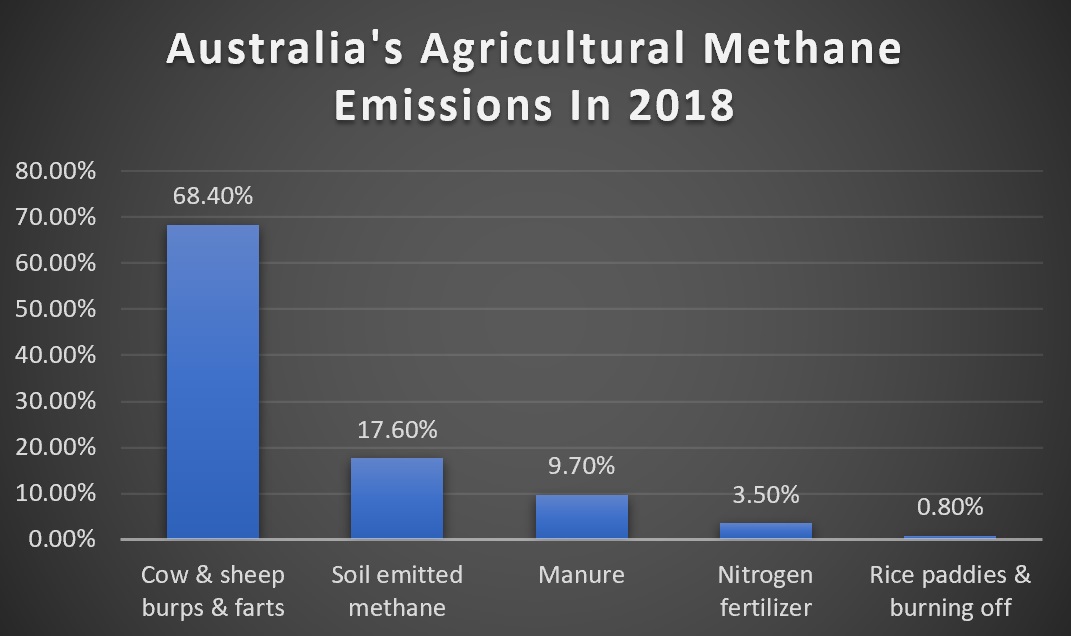
Information ripped from this WA Department of Primary Industries and Regional Development page.
Over two-thirds of agricultural methane emissions in 2018 came directly from ruminants — animals with four stomach compartments. These are cows, sheep, and goats. (Also giraffes, but farming them never took off here because making the fences high enough is hard work.)
I’m optimistic we can reduce these animal emissions because their methane production results from inefficient digestion. Making it more efficient will reduce emissions and feed requirements, improving the bottom line for farmers. So reducing ruminant methane emissions will be win-win rather than only rear wind.
Some promising methods of reducing livestock methane emissions are:
- Breeding: Animals with the right genetics produce less methane.
- Feed additives: A daily handful of red algae seaweed fed to feedlot cattle can nearly eliminate their methane emissions. This is useful because beef cattle spend around 12% of their 18 month existence in feedlots and produce more methane per day there than in the paddock.
- Increased meat production from non-ruminants such as pigs, poultry, kangaroos, and fish (Admittedly, cattle do better than fish on the plains out of Narrabri.)4.
We can also reduce other sources of emissions. Changing land management practices can decrease emissions from soils, and if feedlots and piggeries get their shit together, they can burn the methane it releases. We could use it to generate electricity on-site or sold, as is done with biogas in Europe. But note the value of natural gas (methane) is likely to fall, so there may not be a strong demand for it in the future.
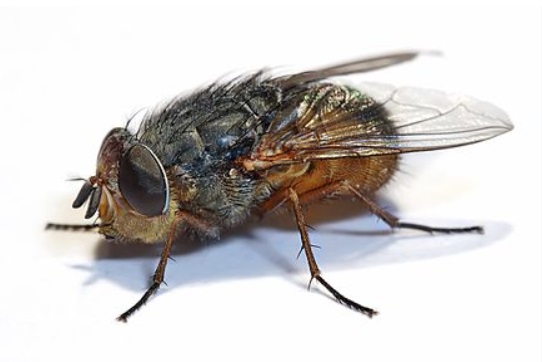
Thanks to its fondness for consuming manure, this annoying thing has done more to reduce methane emissions than our entire Federal Government. Not only does it beat them on environmental issues, it’s beating them in their primary area of expertise. (Image: Wikipedia)
Nitrogen fertilizer can increase emissions because it feeds methane-producing microorganisms in the soil and the water systems it enters. Because farmers don’t like to waste money by adding more nitrogen to crops than is necessary, improved management has the potential to benefit farmers and the environment.
Waste Emissions
Around 10% of Australia’s methane emissions are from waste, and most of it comes from landfills. Australia already has projects to capture landfill methane and either burn it off or use it for electricity generation. Simply continuing what’s already underway will reduce emissions.
Joining The Global Methane Pledge Is An Easy Win
I’m not saying it would require no effort to cut methane emissions 30% over the next eight years. But I will say, thanks to declines in fossil fuel consumption and options available to reduce emissions from beef production and in other areas, it wouldn’t be difficult for Australia to meet the requirements of the Global Methane Pledge.
We should have joined and taken the easy win.
While our Prime Minister lacks the moral fibre to take any positive action to reduce fossil fuel consumption, he should at least have been devious enough to realize emissions will fall anyway and had Australia take the Pledge. He could have provided inadequate extra funding for emission reductions in agriculture, waste disposal and other areas, and allowed the inevitable decline in fossil fuel consumption do the rest.
But he couldn’t even manage that.
I know when it comes to climate change, Scott Morrison appears utterly unwilling to act in the interests of Australians and instead continues to put lives at risk for his own short term personal gain. He definitely gives the impression all he does is reject practical measures to reduce emissions, while going up on the world stage to take credit for cuts that occurred anyway.
But I have to give credit where credit is due. He’s not completely useless when it comes to the environment. Scott Morrison has — single-handedly — caused more harm to the Australian coal industry than any other Prime Minister in history:
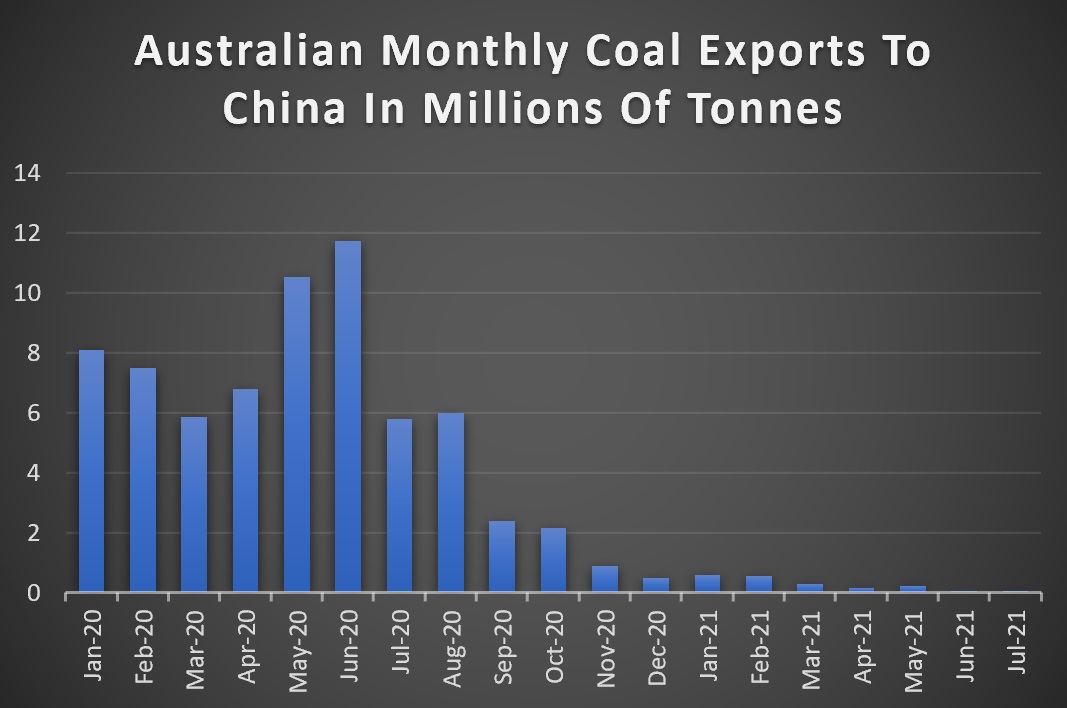
Information from KLER. Graphs showing Australian thermal and metallurgical coal exports to China can be found here.
Footnotes
- Or 28 times as much warming, according to people using older figures or those who think it makes sense to take the bottom of a range of values rather than the middle. ↩
- If you see a much higher figure, that’s after it has been converted into CO2 equivalent. (Or the figure could just be wrong. That’s a possibility.) ↩
- Ending Australian coal generation over 5 years won’t be without challenges, but we seriously don’t have anything better to do. Apart from “Don’t die from COVID”, there’s nothing else marked down in our national five-year planner. ↩
- Fake meat made from plants also has the potential to reduce demand for beef and lamb — but I don’t see our government pursuing that as a policy. ↩

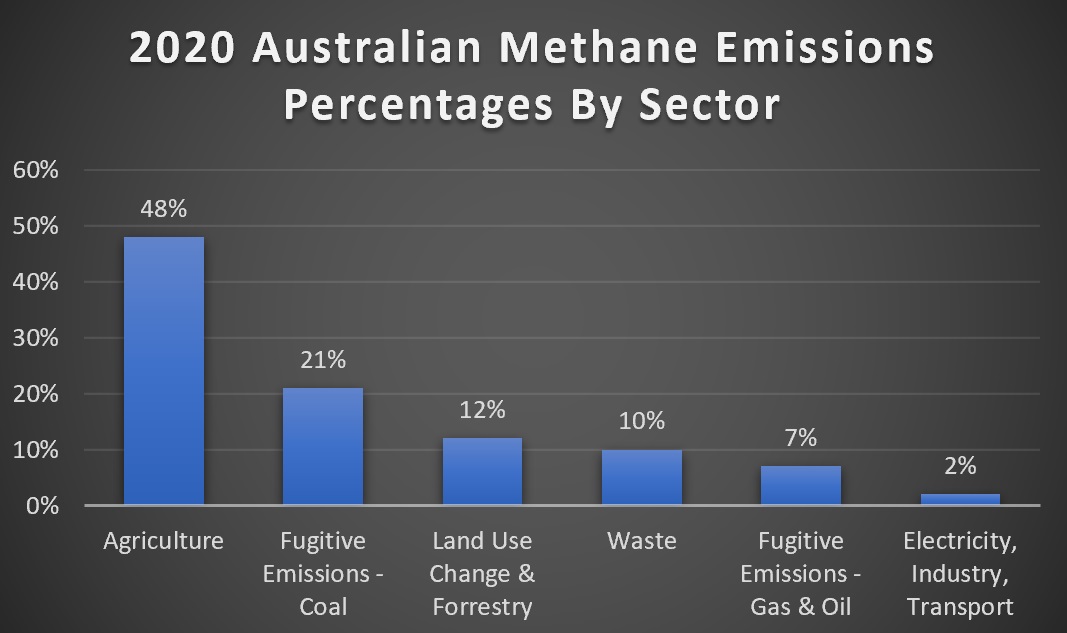
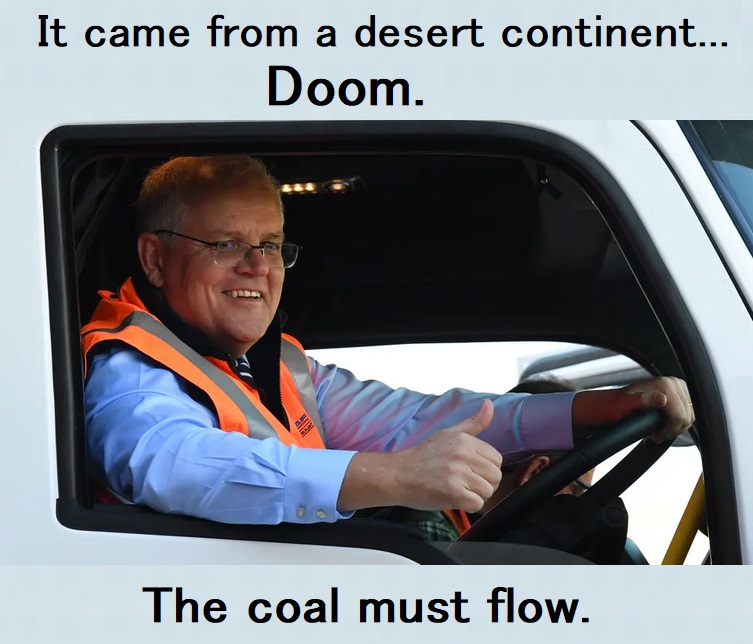
 RSS - Posts
RSS - Posts



Whole-heartedly agree. Australia is turning out to be the stupid nation. Our politicians are weak and stupid. Yet we the Australian people are also largely too stupid to be brave and vote where it counts to send them packing… that being said, it’s not like we have great alternatives amongst our political parties.
Maybe the issue is that democracy has lived it’s life and now just doesn’t support the complex and diverse issues facing the world? Whilst I would argue that climate-change as a potential existential crisis should basically override any other shorter term concerns, such as financial management (or perceived mismanagement by certain parties over others), maybe if we had something like “Direct Democracy” then the Australian people could vote directly on policy initiatives such as climate positive legislation and not continually be stuck in a situation where we can only vote every 3 or so years between basically 2 parties who have both good and bad policies that get lumped together and mean that we all always lose!?
We haven’t tried real democracy yet. We’ve only had our electoral aristocracy so far in Australia (and most other western states!).
I suspect that we would find it to be much more effective, much more efficient, and much cheaper.
Hey Coreying,
Be careful what you ask for mate, because there are lots of idiots out there that might decide to vote very stupid on subjects that a lot of us know very little about.
Australia is a wonderful and beautiful place place to live.
With the current arrangement of only one day of (badly misinformed!) democracy every 3 years, unfortunately it means that, the rest of the time, we have a small group of career politicians making governance decisions on behalf of their employer (their Party), whether or not that coincides with the public interest.
This is true regardless of which Party is currently in power.
It could be argued that it is not a very effective nor efficient system of governance.
#RealDemocracyNow
#Sortition
#CitizensAssemblies
#CitizensJuries
Hey Old Gregg,
Just keep in mind just how lucky or blessed we have been in this country. Australia is the lucky country and I don’t think it happened by chance mate. So maybe something has been going right. Let’s not follow the other idiots and burn it all down because it isn’t totally perfect.
Appreciate your thoughts though.
I know it’s called “the lucky country”, but it wasn’t really luck. We took it by force, and made it as much like home as we could, bringing our British industries here to a place that is much less productive per hectare, but which has a heck of a lot of hectares compared to home.
Keep in mind that not all of the continent’s residents have been lucky or blessed by our presence.
All that aside, we can all observe how defective our old British governance system is, and we have means to improve it, should we decide to do so.
Come to think of it, our current government’s preference to have faith in future technology and future citizens, rather than taking action now with readily available technology, relies on current youngsters to develop and implement those “technologies”. Current youngsters, of Greta Thunberg’s generation, just like she has been saying all along! Ha ha
China, India, and Russia not bothering? Then it’s a waste of time. Those 3 nations produce over a third of global methane emissions by themselves. Thus any action Australia takes, even something as absurd as completely banning methane production, would be serious pain for no gain – all three nations are more concerned with expansion than Western environmental imperialism. Note too that if you look at methane emissions on a per mile basis – Australia is an ultra large but lightly population nation, then the country is far down the listing for production, same as how Australia is, from memory 135th out of 184 nations for CO2 emissions per square mile.
If half of Australia’s emissions are from agriculture then not only are the regions at risk – threat of increased costs and rising unemployment due to sudden unprofitability, but that translates to votes. If the government won’t support areas outside the cities then those areas won’t vote for the government and they won’t retain government. It’s simple logic.
The fugitive emissions issue is similar. Curtailing employment in the regions, or raising costs – which leads to increased unemployment anyway, translates to votes against the government, though I confess I’m not sure who the alternatives would be – Shooters, Fishers, & Farmers; Pauline Hanson; Katter’s Australian; rogue independents; someone else? Whatever the government decides it has to do so with the trust of its electors.
Right! I’m off to rob a bank!
What does robbing a bank got to do with this?
Well, if there is no point in cutting methane emissions because other countries emit more than we do, there’s not point in me not robbing a bank. If Australia’s methane emissions don’t matter, then clearly my robbing a bank won’t matter either since the US has at least 15 times more per year than we do. It’s not going to hurt anyone.
Hey Ronald,
Robbing a bank is against the law?.
But here’s the thing mate.
When you and everybody else that is screaming we are having an existential crisis because of CO2 and now methane stop doing any and everything that produces these gases then maybe the government will pay more attention and who knows it may even turn the markets the way you want it to.
My two cents worth.✌️??
I don’t know anyone who screams we are having an existential crisis because of CO2 and/or methane, so I don’t think that will result in much of a drop in emissions.
One more question Ronald,
Are you doing anything that contributes to CO2 and methane gases being released.?
If not what are you doing so we can do that too.?
But if you are wouldn’t you call that “the pot calling the kettle black”??
Thanks for your articles but ✌️??
Bob, if there is something wrong in the article, point it out. If you disagree with my conclusions you’re free to do that. But if you want to claim my conclusions are wrong because I’m not moral enough you have to marry me first. Otherwise, address my arguments on their merits.
Hey Ronald,
Thanks for your reply?
It’s just that I hear way too many people grumble, complain and call names about government, politician and people that don’t believe in climate change because they are not doing enough or the right thing. But I am yet to see people that grumble change their ways first and I find it disingenuous and it seems you are all waiting to be told or governed by government to change.?♀️
If you want change then you change first yourself is all I’m saying. If you write about that and educate people on what they can do then people may take you more serious. ?????
Keep up the good work. ✌️??
Well, I definitely recommend everyone with a roof put as many solar panels on it as will reasonably fit. This way they can save money and reduce greenhouse gas emissions.
I don’t want anyone to be worse off when its comes to cutting emissions. What I want is for everyone to avoid the very high costs that may result from not taking precautions now. When the oil light comes on you add oil to the engine immediately, not next week.
Crikey, George. It seems a bit optimistic for a citizen of Australia (15.2tCO₂pa) to tell a citizen of China (7.415.2tCO₂pa) that they need to reduce their emissions.
HI George – IMO, simply because other non-committed countries are large emitters is not an excuse for smaller “problems” like Australia to simply ignore the issues.
This is a total copout used by politicians all the time. “Oh if Australia got to net zero tomorrow it would make no difference.” The truth is – we’re one of the highest per capita emitters of CO2 in the world and probably the highest exporter of emissions. Blaming China and India when the rest of the world keeps exporting manufacturing and therefore CO2 emissions to them is just passing the buck.
I think it might actually help if we show leadership in this area. And help to bring pressure on those non conformers (not that China is actually likely to take notice) but if the Murdoch Press turnaround has proved anything – it’s proved that you can change even the most intractable if enough pressure is brought to bear (in their case advertising dollars).
George Kaplan,
I see there’s plenty of gain for Australia to electrify everything and exit fossil fuels.
Dr Saul Griffith in the YouTube video presentation titled Our Energy Future — Part 2: Crushed Rocks, includes:
* from time interval 0:14:16, all Australia’s coal and LNG exports currently don’t quite pay for Australia’s petroleum fuel imports.
* from time interval 0:35:29, only a small fraction of iron ore processing to steel in Australia would make up all losses in fossil fuels.
*from time interval 0:35:52, Australia could be the world’s foundry, using cheap renewable energy to process iron, aluminium, copper, manganese, zinc, nickel, cobalt, lithium, rare earths, silicon, etc., etc. to base metals; or value-add further to manufacture batteries, wind turbines, BEVs and heat pumps, etc.
The vast opportunities are there if Australia has the vision and will to proceed.
I beleave everyone on these forums would have solar panels so we are all doing something to help.
On the methane front, personally i compost.
I think i have halved my weekly waste going to landfills this way, and i am also improving my gardens(which i assume also catches carbon)
It is something i would recommend others to do as well.
Before starting it i thought it would have a rotting food smell, but when working its actually has a nice earthy smell.
Something else i might try to cut back on methane is eat more Roo. I have tried it a few times and have found nothing wrong with it, i suspect it might even be a healthier alternative.
I’ve tried kangaroo and found it to be far too dry to be palatable. Maybe it’s just how it came, and how it was cooked e.g. slow cooking it might make it better, or perhaps kangaroo bacon instead?
Crocodile, surprising as it may sound, can be pretty good, but it’s not something that’s easily accessible, and not a creature that can be farmed easily, or at least not grass fed.
Random idea, what about apacas or llamas as meat animals? Apparently it is a thing in Australia (https://alpaca.asn.au/alpaca-resources/alpaca-meat/) but I’ve no clue where you’d find the meat. And given my aforementioned concerns about costs and unemployment, perhaps the government could subsidise a shift to a more environmentally friendly herd option? Voters on the Right would be pleased to see rural areas getting support, and those on the Left would be pleased to see environmental action, right?
Hi James Silcock
Yes, I understand Kangaroo meat is extremely low-fat (that’s why it is so important not to overcook it, otherwise “it will get far too dry to be palatable”) – so I guess it must be a healthier choice (unless you like your meat greasy – I don’t). I have eaten it, but not on a regular basis (lack of availability).
But isn’t Compost just a mini-version of landfill? Rotting food will generate CO2, and also Methane from anaerobic decomposition http://www.madsci.org/posts/archives/2005-01/1106120458.Bc.r.html. Probably something like bio-fuel from a digester – maybe you could capture this to heat water? We have a worm-farm – but I’d guess a similar result. The plus side – if methane is eliminated – is that for a static population this should be carbon-neutral – the emitted CO2 will be absorbed to grow new replacement vegetables, fruit, etc.
I know of a local landfill that has pipes to capture methane emissions from their landfill, and they run pilot-ignited diesel engines from this to make electricity to partly run the rest of their plant – not sure if is still running.
The good side of burning CH4 (methane), is that it then doesn’t have such a powerful GHG effect – however a product of burning methane, is CO2 – which is of course another GHG, although far less critical.
If oxygen is present methane produced by composting is minimized. Here’s some WA info on it:
https://www.agric.wa.gov.au/climate-change/composting-avoid-methane-production
Yes, I had noted that methane was produced by anaerobic microbes – as you would get unavoidable in a compacted landfill.
I see that can be avoided, so long as composting is done properly. My own experience many years ago with a home composing drum, that you were to rotate regularly to aerate the mix, proved rather poor. The process was extremely slow, extremely prone to going wrong (e.g. drying out in our hot summer), and lacked capacity to ‘keep up’ with even modest waste generation.
I don’t know that the piles of material you often see on garden shows, would practically remain aerobic.
Now, I’m hoping our worm farm, which is very easy to use and a prodigious consumer, does not generate methane – hopefully the worms provide aeration!
“tragedy of the commons”
I think everyone needs to look it up! Including Scott Morrison 🙂
Hi Ronald
I see many of Australia’s CCGT plants are powered from coal-seam gas.
Interesting that 21% of methane emissions are from coal mining operations. Perhaps we need to add in some extra GHGs for blast furnaces making steel for fabricating the coal mining equipment – and then operating it. Oh – and for the iron ore mining before that – and transport.
Yet, we are going to keep charging our shiny-new BEVs from coal-fired power stations for quite a while yet – unless we get to the point of being able to use wasted renewable ‘spill’ energy, rather than divert it to supplant coal power in use for other activities. COAL is king!
And, many if not most will charge their BEVs at night, when there is no PV in sight.
Of course, SAs BIG BATTERY will be able to supply 0.04GW for a few hours! (a week or so ago, I saw on the NEM-widget after dark with a ~ 25 GW demand, that the total wind generation throughout the whole of Australia was barely 1 GW – nearly half in WA). SA has A LOT of NG power generating capacity – and was drawing on coal power over the interconnector.
Seems a great recipe for INCREASING our contribution to global GHG emissions, to me. I, too, bemoan the lack of a pledge.
One guy is about to build a mega solar farm and run a cable to another county across the ocean and make it profitable but our government can’t see any money in building them outside of our major cities, they really do have rocks in their heads, black rocks and dollar signs in their eyes.
Ronald,
You state: “There is some dispute over how accurate they are, but I’ll assume they’re close enough for the back of the envelope estimates I make in this article.”
The accumulating evidence/data suggests methane emissions are much worse than estimates for some sectors.
Per an ABC article by Peter McCutcheon on Sep 28 headlined Methane emissions higher than previous estimates in Queensland’s Surat Basin CSG region, it includes (bold text my emphasis):
https://www.abc.net.au/news/2021-09-28/methane-emissions-higher-than-estimates-in-coal-seam-gas-region/100497292
Recently launched and now operational (with more scheduled to come) methane-hunting satellites are finding methane leaks from landfills, oil fields, natural gas pipelines and more.
https://e360.yale.edu/features/in-push-to-find-methane-leaks-satellites-gear-up-for-the-hunt
Ha ha. Kangaroo is the world’s premium red meat, yet we indigenous British people disparage it, like all other Australian foods (except one, for which we eventually jumped on the bandwagon after we saw how much money the foreigners were making from it – does anyone know what that might be?).
Care to give us an answer? Camel and deer aside, I can’t think of any other likely land based meats, and I doubt you’d consider them Australian.
Not a meat. The ONLY Australian food that, to my knowledge, is currently available in supermarkets is…
… the macadamia.
We wouldn’t even be eating it now, except that in 1880, it was grown in an orchard in Hawaii, successfully commercialised and available retail by 1920. Hawaii was the world’s largest supplier until the 1980s. We in Australia started growing macadamias commercially in the 1980s and 1990s, but by that stage South Africa had become the world’s largest supplier.
We have the climate for macadamias (obviously) but we also have the pests. This is why the highest output per hectare eucalyptus plantations are in Brazil.
A quick look at Wikipedia suggests Australia did have a commercial orchard as far back as 1888 while the Hawaiian Agricultural Experiment Station didn’t encourage planting of macadamias until 1910. While its true that Australia didn’t overtake America as the largest producer until the late 90s, and South Africa took the lead in 2012, is it that Australia wasn’t growing them commercially until then, or that local growers couldn’t see enough demand\opportunity outside Australia before then?
Consider Kiwifruit. While seen as an NZ thing, China produces 5x the tonnage, and even Italy produces a third more. (And yes I’m aware Chinese gooseberries are native to central and eastern China).